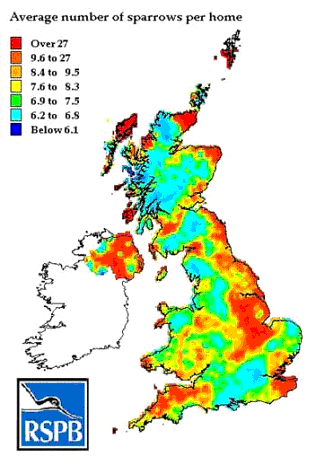The RSPB has published the preliminary findings of the nationwide survey it ran during May this year as part of a wider investigation into the dramatic population decline of this species.
 The garden house sparrow distribution map.
The garden house sparrow distribution map.
Long term population analysis has shown that house sparrow numbers have declined by 62% in the last 25 years. In some areas the decline has been even more dramatic. It wasn't until the early 1990s that people began to realise that losses in towns and cities were particularly bad. As part of its effort to find out why, the RSPB this year asked anyone with a garden to count the maximum number sparrows using it at any one time during the period 1st to 8th of May. An amazing quarter of a million people sent in their results.
Around 1 million sparrows were counted. A staggering 15,000 respondents didn't see any sparrows at all - disappointing for them but a very significant result nevertheless. The results allowed the RSPB to create a map showing how the sparrow population densities vary over the country. There are some clear patterns; among them a link between lower population densities and highly urbanised areas. Despite the lower densities, city gardens do still support very significant populations because of the large numbers of gardens within them.
 The preliminary analysis also suggests a strong link between higher garden populations and gardens where food is put out for birds all year round
The preliminary analysis also suggests a strong link between higher garden populations and gardens where food is put out for birds all year round
The preliminary analysis also suggests a strong link between higher garden populations and gardens where food is put out for birds all year round. The average count in these gardens was 7.3, while the figure for gardens where birds were not fed was 3.8. A lot more analyses of the data represented by this map will be carried out; comparing it with, for example, soil types, pollution levels, farming practices and so on.
The RSPB suggest a three point plan for people to help sparrows in their gardens. Even if you do not have any regulars in your garden at the moment, they may be close by, so everyone can help by:
- putting up nest boxes (modern house designs and improvements have resulted in fewer nesting places for sparrows);
- feeding birds throughout the year (especially with seed) and providing them with clean water;
- leaving wild, weedy or shrubby areas in the garden to provide a natural seed source and supply.